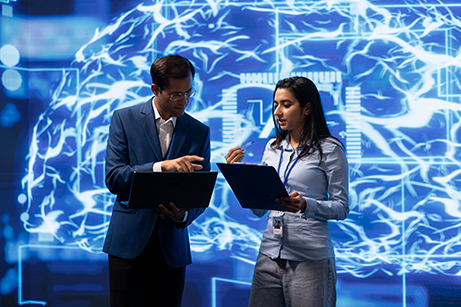AIMC Topic: Dyslexia
Clear Filters Showing 1 to 10 of 24 articles
Lightweight hybrid transformers-based dyslexia detection using cross-modality data.
Scientific reports
May 16, 2025
Early and precise diagnosis of dyslexia is crucial for implementing timely intervention to reduce its effects. Timely identification can improve the individual's academic and cognitive performance. Traditional dyslexia detection (DD) relies on length...
Distinct connectivity patterns between perception and attention-related brain networks characterize dyslexia: Machine learning applied to resting-state fMRI.
Cortex; a journal devoted to the study of the nervous system and behavior
Nov 8, 2024
Diagnosis of dyslexia often occurs in late schooling years, leading to academic and psychological challenges. Furthermore, diagnosis is time-consuming, costly, and reliant on arbitrary cutoffs. On the other hand, automated algorithms hold great poten...
An abbreviated Chinese dyslexia screening behavior checklist for primary school students using a machine learning approach.
Behavior research methods
Jul 29, 2024
To increase early identification and intervention of dyslexia, a prescreening instrument is critical to identifying children at risk. The present work sought to shorten and validate the 30-item Mandarin Dyslexia Screening Behavior Checklist for Prima...
Unraveling Brain Synchronisation Dynamics by Explainable Neural Networks using EEG Signals: Application to Dyslexia Diagnosis.
Interdisciplinary sciences, computational life sciences
Jul 2, 2024
The electrical activity of the neural processes involved in cognitive functions is captured in EEG signals, allowing the exploration of the integration and coordination of neuronal oscillations across multiple spatiotemporal scales. We have proposed ...
ChatGPT and dyslexia: correspondence.
Disability and rehabilitation. Assistive technology
Nov 27, 2023
Deep learning classification of reading disability with regional brain volume features.
NeuroImage
Apr 11, 2023
Developmental reading disability is a prevalent and often enduring problem with varied mechanisms that contribute to its phenotypic heterogeneity. This mechanistic and phenotypic variation, as well as relatively modest sample sizes, may have limited ...
A novel approach for detection of dyslexia using convolutional neural network with EOG signals.
Medical & biological engineering & computing
Sep 5, 2022
Dyslexia is a learning disability in acquiring reading skills, even though the individual has the appropriate learning opportunity, adequate education, and appropriate sociocultural environment. Dyslexia negatively affects children's educational deve...
An Efficient Machine Learning-Based Feature Optimization Model for the Detection of Dyslexia.
Computational intelligence and neuroscience
Jul 9, 2022
Dyslexia is among the most common neurological disorders in children. Detection of dyslexia therefore remains an important pursuit for the research works across various domains which is illustrated by the plethora of work presented in diverse scienti...
Clustering analysis of factors affecting academic career of university students with dyslexia in Italy.
Scientific reports
May 30, 2022
This study was designed to explore learning experiences of university students with dyslexia and factors that could contribute to their success in the university career. Although, great efforts have been made to diagnose dyslexia and to mitigate its ...
Detecting Phase-Synchrony Connectivity Anomalies in EEG Signals. Application to Dyslexia Diagnosis.
Sensors (Basel, Switzerland)
Oct 25, 2021
Objective Dyslexia diagnosis is a challenging task, since traditional diagnosis methods are not based on biological markers but on behavioural tests. Although dyslexia diagnosis has been addressed by these tests in clinical practice, it is difficult ...
Popular Topics
- Machine Learning 31964
- Neural Networks, Computer 30201
- Algorithms 27375
- Deep Learning 26880
- Artificial Intelligence 24818
- Robotics 13382
- Image Processing, Computer-Assisted 9730
- Retrospective Studies 9328
- Magnetic Resonance Imaging 6341
- Reproducibility of Results 5670
- Tomography, X-Ray Computed 4863
- Support Vector Machine 4762
- Computational Biology 4328
- Brain 4125
- Computer Simulation 3932
Recent Journals
- Scientific reports 6689
- Sensors (Basel, Switzerland) 4794
- PloS one 4186
- Neural networks : the official journal of the International Neural Network Society 3026
- Computational intelligence and neuroscience 1931
- Computers in biology and medicine 1915
- Annual International Conference of the IEEE Engineering in Medicine and Biology Society. IEEE Engineering in Medicine and Biology Society. Annual International Conference 1686
- Studies in health technology and informatics 1378
- IEEE journal of biomedical and health informatics 1167
- Journal of chemical information and modeling 1059
- Nature communications 1029
- Computer methods and programs in biomedicine 883
- Bioinformatics (Oxford, England) 872
- Journal of medical Internet research 853
- Briefings in bioinformatics 853
